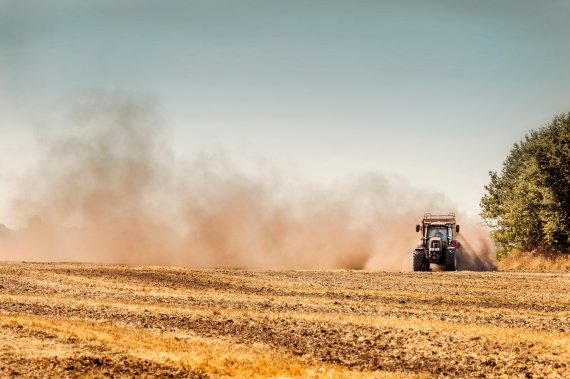text Roelof Kleis photo Normafotografie/Hollandse Hoogte
‘A summer like this is a gift,’ says Henny van Lanen of the Hydrology and Quantitative Water Management chair group. He has been working on drought at WUR for nearly 30 years but he feels the topic has never got the attention it deserves in the Netherlands. ‘The focus has always been very much on how to avoid flooding. Resolving the problem of drought is not ingrained in the same way. We don’t even use that word; we use the more neutral term “freshwater provision”.’ When asked what lesson can be learned from the latest period of drought, Van Lanen’s reply — ‘Don’t be late’ — is short and to the point. ‘What this summer taught us is that we should have been much quicker to take measures. An example: it was already clear in early May that June and July could turn out incredibly dry. But the decision to raise the water level in the IJsselmeer was only taken in mid-June, by which time there wasn’t much water left in the Rhine.
Raising awareness
Phenologist and climate scientist Arnold van Vliet of the Environmental Systems Analysis group had an excellent summer. He was forever talking to the media. Which was good for his profile but even better for raising awareness about climate change, he says. ‘Because it stayed hot and dry for so long, journalists were continually looking for new angles. That gave an opportunity to take a much broader look at the problem than is usually possible when the media cover extreme weather.’ Van Vliet says the incessant media coverage boosted the general public’s interest in climate issues. ‘Everyone saw the effect of the drought in their own back gardens. That helped stories about drought to catch on better. You can’t see high temperatures but you can see drought.’
According to Van Vliet, it is difficult to say what consequences one dry summer like that will have for nature. ‘It’s tricky to disentangle the impact from the extreme weather we’ve already had in recent years.’ For the bigger picture, he refers to the study that the ecologist Wieger Wamelink of Wageningen Environmental Research published this summer. Wamelink calculated that climate change would lead to the loss of 40 percent of all today’s plant species in the Netherlands by 2085. That would at any rate be the case if the average temperature on Earth rose from the current 10 degrees to 14 degrees.
The shivers
But even a more realistic increase to 12 degrees would have a huge impact. Wamelink: ‘Even then, 207 of the 1200 species we investigated — 17 percent — would be in trouble. That is, it would become too warm here so their range would shift northwards. More than one third of these species are on the Red List, which means they are already rare.’ ‘That gives me the shivers,’ says his colleague Van Vliet. ‘I can’t bear to think about it. The consequences are massive. And they include prominent species like the oak.’
Set against the loss of these species is the fact that the Netherlands will potentially become more suitable for 234 new plants. Wamelink: ‘Their range will also shift northwards; it will become warm enough here for them to survive. So we could gain more plants than we lose.’ But that is a scoreboard approach. ‘There are species that only shift their range by a couple of metres a year. That’s too slow to keep pace with global warming. The soil also has to be just right. In general, Dutch soil is more acidic than the soil in the south of France. So it’s not simply a question of adding and subtracting. It’s not really possible to predict what will happen.’
Twitter tree
Despite this, it is possible to say something about the effect a dry summer has at the micro-level. Take the Twitter tree set up by Ute Sass-Klaassen, a researcher at the Forest Ecology and Forest Management group. The poplar next to Orion has been keeping precise track of what happens to it for more than a year now. Meters and sensors monitor changes in the tree’s diameter and sap flows, changes that the tree then shares with the outside world via Twitter.
The most recent data shows that the drought has had a clear effect. While the diameter increased by nearly a centimetre last year, the increase this year was only 0.6 centimetres, 37 percent less. ‘That’s because the tree stopped growing in mid-June in response to the drought, more than a month earlier than last year,’ says Sass-Klaassen.
One dry summer is not the end of the world, says Sass-Klaassen reassuringly. Trees do not easily give up the ghost. ‘But only time will tell whether and how well they recover. It was incredibly tense seeing what would happen this summer but 2019 will now be similarly nerve-racking.’
Freshwater strategy
The dry summer of 2018 is making us face facts, say Wamelink and his colleagues. ‘One important lesson is that we really need to prepare more for climate change,’ argues Wamelink. ‘Should we aim to keep what we already have or prepare for what might be ahead? We haven’t been talking about that enough. A summer like this is ideal from that perspective.’
One important lesson is what we need to prepare more for climate change
‘Drought should have a similar priority in policy to flooding,’ says the hydrologist Van Lanen. ‘The Netherlands didn’t develop a national freshwater strategy until 2010. That’s late compared to the rest of Europe. And really rather scandalous when you consider how much expertise in water matters we have here. It then took until 2015 before the Freshwater Delta Plan was adopted. We’re still working on the implementation.’ Then, with deadpan delivery: ‘So the summer of 2018 was a little too early.’

